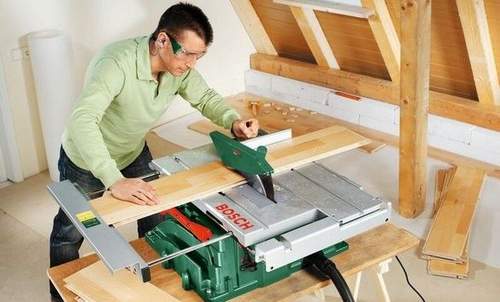How to Properly Sharpen a Circular Saw
The circular saw, which is still called circular according to old memory, is an indispensable tool for the owner of a private home ownership. It copes equally well with wood and drywall, non-ferrous metal or acrylic glass, but one of the conditions for high-quality and trouble-free operation is regular sharpening of the cutting disc. The cleanliness and durability of this tool is much higher than other types of tools for sawing hard materials.

Circular saw (circular) is designed for cutting a wide variety of materials. In the process, the teeth become dull and need to be sharpened correctly.
The circular is in no way inferior to the chain chainsaw popular among the population, and even in many ways surpasses it in capabilities. With its help, it is possible to produce transverse, longitudinal or inclined cutting of the material necessary for the construction or manufacture of carpentry. The number of teeth on the circular saw blade depends on the hardness of the material being processed, but in any case, its correct movement can be ensured only by correct wiring and sharpening of the teeth.
Signs of wear on the saw blade
Circular saws, subject to all operating rules and careful maintenance, are reliable and durable, but, like any tool, they require preventative maintenance from time to time. If during the operation of this equipment difficulties became noticeable and dark marks appeared on the surface of the material, it means that the edges of the cut burn out from excessively heated saw teeth. In combination with smoke and an unpleasant odor during operation, which can occur from overheating of the engine cover, this most likely indicates that the tool requires immediate sharpening.
Видео: How to Properly Sharpen a Circular Saw
Timely sharpening of circular saws to a large extent affects the smooth operation of the electric motor.
Circuit diagram for circular.
A dull disk increases the load on the mechanism many times and can lead to its complete failure. The main degree of wear is on the upper cutting edge of the teeth on the circular saw blade. To blunt the tool does not become excessive, you should regularly check the radius of rounding of the cutting edge, which according to the rules should not exceed 0.1-0.2 mm. It is possible to determine that urgent sharpening of a circular saw is necessary also in the form of the cut itself. Regular sharpening of the disc will not only extend the uptime of the equipment, but will also increase productivity, as well as reduce the time and effort that is required to put in order a completely worn tool.
Do-it-yourself sharpening a circular saw
The method of sharpening the circular disc depends on the availability of the necessary tools at hand. If it is not possible to use a special machine for this purpose, then a good result can be achieved by having a minimal set of files, a vise and a pair of wooden blocks for fixing the disk.
Circular grinding disk circular on the machine.
Sharpening the part will be more convenient if you do not remove it from the machine, but first you need to remember to disconnect the equipment from the power supply. To begin with, it is necessary to ensure reliable fixation of the disk using wooden blocks placed under it on both sides. The toothed disc, located separately from the saw, is placed in a vice, holding it with wooden wedges. It is better to mark the first tooth from which the treatment begins, using a bright marker, so as not to perform actions on the second round.
Start work from the back. When sharpening the teeth, it is necessary to control the uniformity of the applied efforts as much as possible and try to observe the same number of file movements in each case. In order to train your hand in this action, you can use an old hacksaw to start with, which will not spoil AL-KO.
Checking the quality of the blade sharpening is carried out with a trial cut. Uneven material advancement and extraneous noise may indicate that the teeth are at different levels. This can be revealed by bringing the marker close to the cutting edge of the disc and making it a complete revolution in the direction opposite to normal work. Prongs that have been marked require re-file processing.